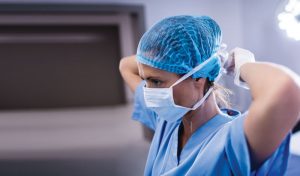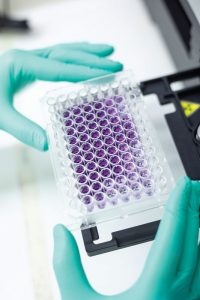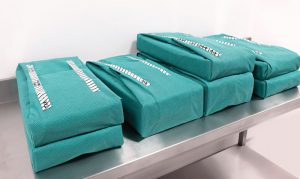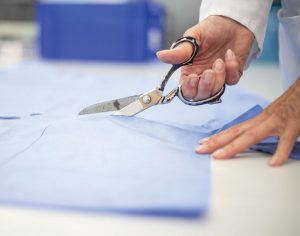
Success in global medical textile markets requires an understanding of global regulatory standards and testing protocols.
By Dr. Timo Hammer
Around the world, millions of people a day receive medical care in hospitals and clinics. Most take for granted that the bandages, gowns and other materials they encounter are safe. But what are the criteria that govern those standards?
Advancements in technology and a burgeoning demand for specialized textile applications continues to drive exponential growth in the medical textile industry. From wound care to surgical garments to filtration systems in medical devices such as ventilators, the scope of medical textiles reaches every corner of the healthcare industry. As these products become increasingly vital in hospital and healthcare settings, manufacturers must navigate the complex landscape of global regulations and testing protocols to ensure safety and efficacy.
The Diverse Applications Of Medical Textiles
Medical textiles encompass a wide range of products designed for specific health-related uses. These can be broadly categorized into two types: disposable items, which are often utilized in hospital settings; and reusable items, such as surgical clothing and medical compression stockings.
Disposable products are typically designed for single use, promoting sanitation and reducing the risk of infection. Common examples include surgical drapes and sterile wound dressings. These items are used in operating rooms and during patient care procedures, where hygiene is paramount. The materials used in these textiles must meet stringent regulatory requirements, ensuring they are safe for immediate contact with patients.In the other category, reusable items like surgical clothing and compression stockings are engineered for repeated use, requiring longevity and comfort as well as rigorous cleaning and sterilization processes. Surgical gowns, for instance, are designed to withstand repeated laundering while maintaining their protective qualities. Medical compression stockings are designed to provide consistent pres-sure, improving circulation in patients with various medical conditions. The durability and efficacy of these products are essential for their continued use in healthcare settings.
The application of textiles in medical settings extends beyond garments — they also play a critical role in filtration systems used in ventilators, blood purification devices and sanitation equipment. Such innovations highlight the transformative power of textiles in enhancing patient care and operational efficiency in healthcare facilities.

Regulatory Frameworks: European Union And The United States
One of the most significant challenges facing medical textile manufacturers centers around the varying regulatory frameworks in the United States and the European Union. While the outcomes are similar, the differing classifications for medical devices can complicate the introduction of products to different markets.
In the European Union, medical devices are classified under the Medical Device Regulation (MDR) 2017/745. This regulation categorizes devices into four classes — Class I, Class IIa, Class IIb, and Class III —based on the level of risk they pose to patients and operators.
- Class I includes low-risk devices, which are non-invasive and may be sterile or reusable, such as wound dressings and thermometers.
- Class IIa comprises medium-risk devices like catheters, surgical clamps and hearing aids.
- Class IIb devices represent middle-to-high risks found in defibrillators and lasers.
- Class III devices are considered high-risk and require extensive evaluation, including heart valves and joint implants.
For Class I devices, manufacturers can self-declare compliance using the CE marking process, allowing for a streamlined market entry. A CE marking, or “Conformite Europeenne” label, shows that a product meets safety, health and environmental standards set forth by the EU, and is a requirement for many products sold in the European Union.
Class II and higher necessitate verification by a notified body. However, all classes involve assessment and documentation, including the preparation of a Technical File.
The U.S. Food and Drug Administration (FDA) employs a similar risk-based classification system for medical devices. For Class I exempt devices, there is no requirement for independent audits before market release, allowing manufacturers to proceed with a self-declaration process. Most devices require manufacturers to submit a 510(k) premarket notification to demonstrate substantial equivalence to a legally marketed device by providing clinical data and other relevant information. Medical devices that are critical (typically Class III) and for which there are no comparator products require a more rigorous premarket approval process (PMA), demanding extensive clinical trial data to establish safety and efficacy.
These regulatory differences high-light the challenges and complexities manufacturers face in ensuring compliance and achieving market access for medical textiles across both regions.
“It can be tricky for medical device manufacturers seeking to participate in multiple markets,” said Ben Mead, managing director at Hohenstein Institute America, Ligonier, Ind. “Learning the differences early on can save time and money.”

Medical Textile Testing: A Critical Step
Biocompatibility is a key consideration in the development and marketing of medical textiles, as it determines how materials interact with the human body. Testing typically involves both in vitro — test-tube or culture dish — and in vivo —animal or human — studies, depending on the potential risk associated with the textile.
The ISO Standard 10993-1 out-lines the necessary evaluations for biocompatibility, focusing on factors such as the type of body contact and the duration of exposure.Three biological endpoints are standard for biocompatibility assessments in nearly all medical devices:
- Cytotoxicity: Evaluates the potential of a material to cause cell damage. The in vitro test uses living cells to detect damaging sub-stances (cytotoxins) from a sample, measuring the material hazard potential at the cellular level.
- Irritation: Assesses whether a material induces a localized inflammatory response. This in vitro test utilizes 3D human skin models, which are composed of different cellular layers that mimic human epidermis. Measuring irritation specific to mucosal damage to the eyes, nose and lungs still requires testing on animals. In vitro alternatives are under development.
- Sensitization: Determines whether exposure to a material can lead to allergic reactions. There are several types of testing for sensitization, as sequential events lead to a skin sensitizing effect in humans. Although the regulations still require animal testing, the international trend is toward the use and further development of meaningful animal-free methods. In the US, the FDA mandates specific regulations and standards related to bio-compatibility testing, that align with the EU’s required standard, ISO 10993. However, it does not fully recognize all ISO 10993 standards, and manufacturers must provide biocompatibility data with their regulatory submissions for FDA clearance or approval.
A notable challenge in biocompatibility testing arises from the textile supply chain. Manufacturers often lack detailed information about the materials used, complicating the assessment of compatibility. It is prudent to conduct biocompatibility evaluation early in the development process, allowing manufacturers to identify suitable materials before finalizing the product. Additional testing can be done for evaluation on the finished textile device — as well as the packaging for sterile items — to meet ISO 10993-18, the chemical characterization. Failure to adequately assess biocompatibility can lead to adverse patient outcomes and regulatory repercussions.
“Biocompatibility testing can be useful not only to meet regulations, but to protect consumers and reduce litigation risk,” Mead continued. “It is the safest way to prove compliance.”

Cleanliness & Disinfection
Eliminating microbes and germs is critical to ensuring patient safety and preventing healthcare-associated infections. Both the European Union and the United States have established regulations and guidelines that address the cleanliness and disinfection of medical products, though their approaches and specifics vary.
The MDR emphasizes the importance of biocompatibility and microbial limits, necessitating compliance with standards such as EN ISO 13485, which outlines quality management systems for medical devices. Reprocessing and disinfection protocols are guided by the European Committee for Standardization (CEN) in standards like EN ISO 17664 and EN 14885. EN 13795, which specifies the requirements for the performance of surgical drapes and gowns in terms of cleanliness and microbial barrier properties, focuses on the product performance regarding its application. Likewise, DIN SPEC 13257 specifies requirements for single-use foot bandages and defines cor-responding test procedures.
The FDA regulates medical textiles under a similar framework, but the focus on cleanliness and disinfection is articulated through the Quality System Regulation (QSR) and specific guidance documents. The QSR mandates that manufacturers establish and maintain procedures for ensuring the cleanliness of products throughout their lifecycle, including stringent requirements for cleaning, disinfection and sterilization processes. The FDA also references standards from organizations like the Association for the Advancement of Medical Instrumentation (AAMI), which provides guidelines for the cleaning and disinfection of reusable medical devices.
Manufacturers are responsible for validating cleaning processes, and they must provide detailed information regarding the recommended cleaning and sterilization methods on product labels. Various types of testing, including measurement of biological residues left behind after washing and porousness of packaging, can help manufacturers verify claims and meet the requirements for both regions.
A Proactive Approach
As the demand for medical textiles continues to grow, manufacturers must remain vigilant and adaptable. Understanding the intricacies of the regulatory frameworks in the European Union and the United States is essential for successful market entry and product acceptance.
While it can seem overwhelming, a proactive approach to biocompatibility and microbial testing can help guide product development and innovation and enhance product safety and efficacy. Many medical device manufacturers partner with a testing laboratory already familiar with the labyrinth of global regulations, developing a plan specific to their needs and budget.
“Meeting global testing requirements can be daunting, but there are ways to optimize the process,” counsels Jaime Griggs, Brand Partnership director at Hohenstein. “Not every medical device or textile needs the same approach.”
The evolving landscape of medical technology continues to bring better, faster solutions for improving patient care. Manufacturers seeking to succeed in global markets must take a big-picture view that includes adhering to multiple standards — not only to ensure that medical textiles meet regulatory standards but also to fulfill their intended purpose: To keep people safe in a vulnerable setting.
Editor’s Note: Dr. Timo Hammer is the CEO of Life Science & Care at Hohenstein Laboratories, a Germany-based global textile testing laboratory that serves brands and manufacturers. He holds a Ph.D. from the University of Stuttgart-Hohenheim and advanced his knowledge of the medical device industry as Product manager and Medical Marketing manager at Germany-based Xenios AG.
2024 Quarterly Issue IV